Abstract
At least seven models have been proposed for the epithelial transport of IgA, and each model presents particular features which are not generally appreciated. Much of the confusion in this field has been caused by the many conflicting reports about the cellular origin of the secretory component (SC) and the mode in which it is expressed by secretory epithelial cells. The transport model proposed in 1973-74 on the basis of test-tube experiments and immunohistochemical studies has now gained considerable support from observations made on both normal and neoplastic living epithelial cells According to this model, the J ("joining') chain and SC represent "the lock and key' in the selective external translocation of both dimeric IgA and pentameric IgM through serous-type secretory epithelial cell. Incorporation of J chains into these two Ig isotypes during their production in gland-associated immunocytes induces a configurational fit (binding site) allowing them to combine by specific non-covalent interactions with SC in the plasma membrance of the epithelial cell. After being formed on the basolateral surface of the cell, the SC-IgA and SC-IgM complexes are transported in cytoplasmic vesicles to the gland lumen along with some free SC. Covalent stabilization of human secretory IgA during this process depends on unique possibilities for disulphide-exchange reactions and is not an inherent feature of the transport model.
Full text
PDF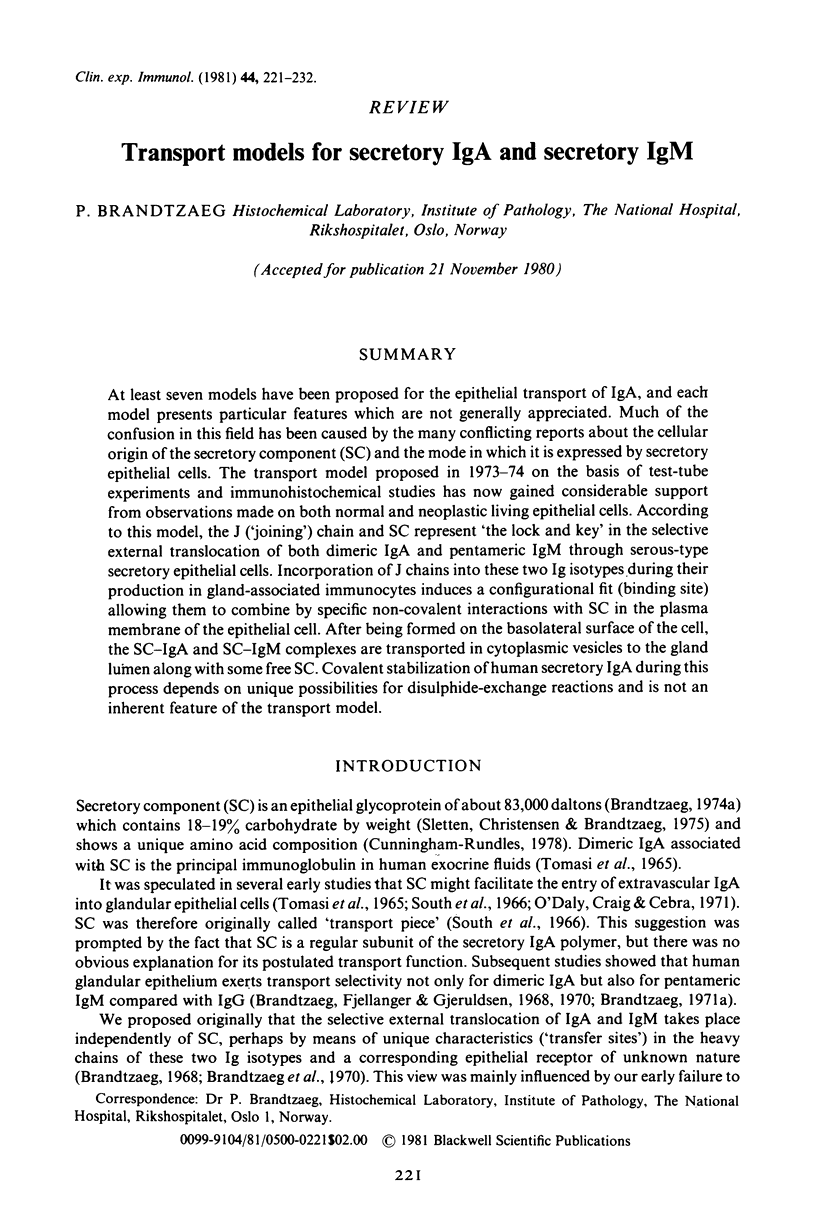
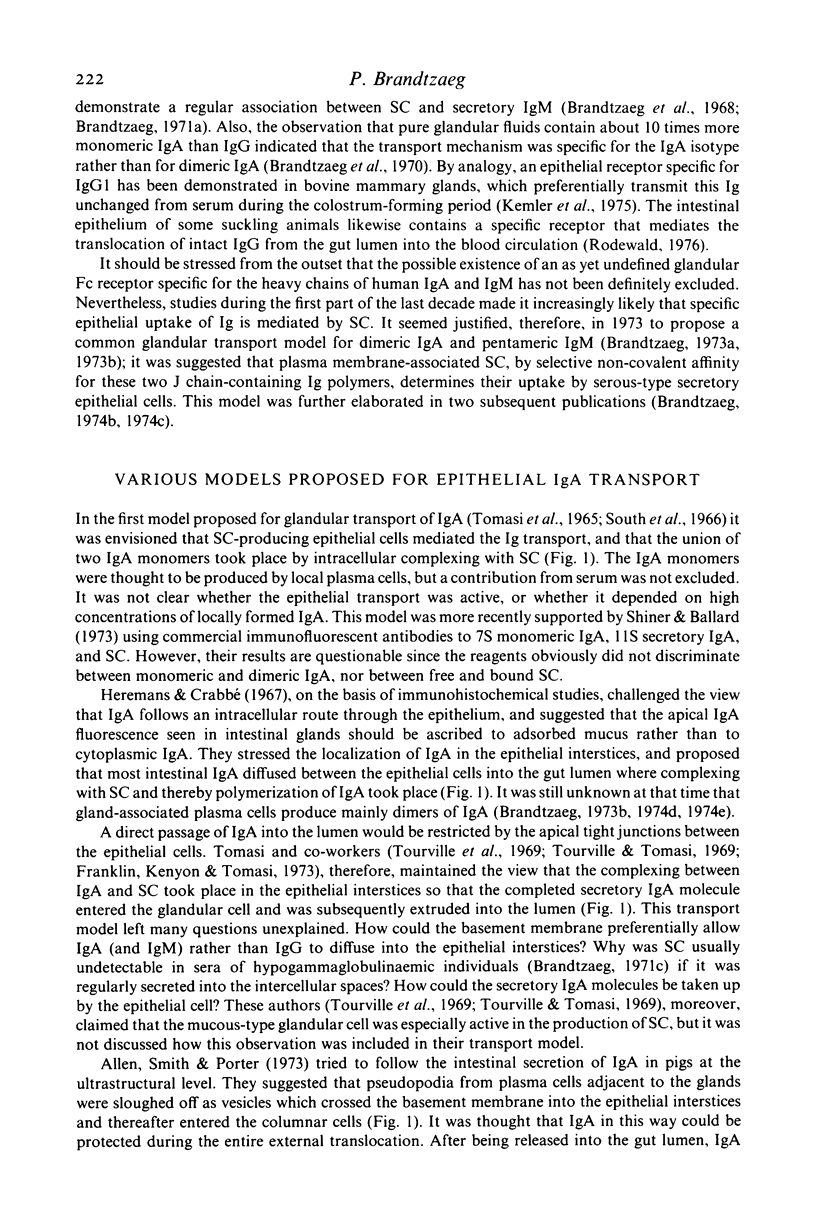
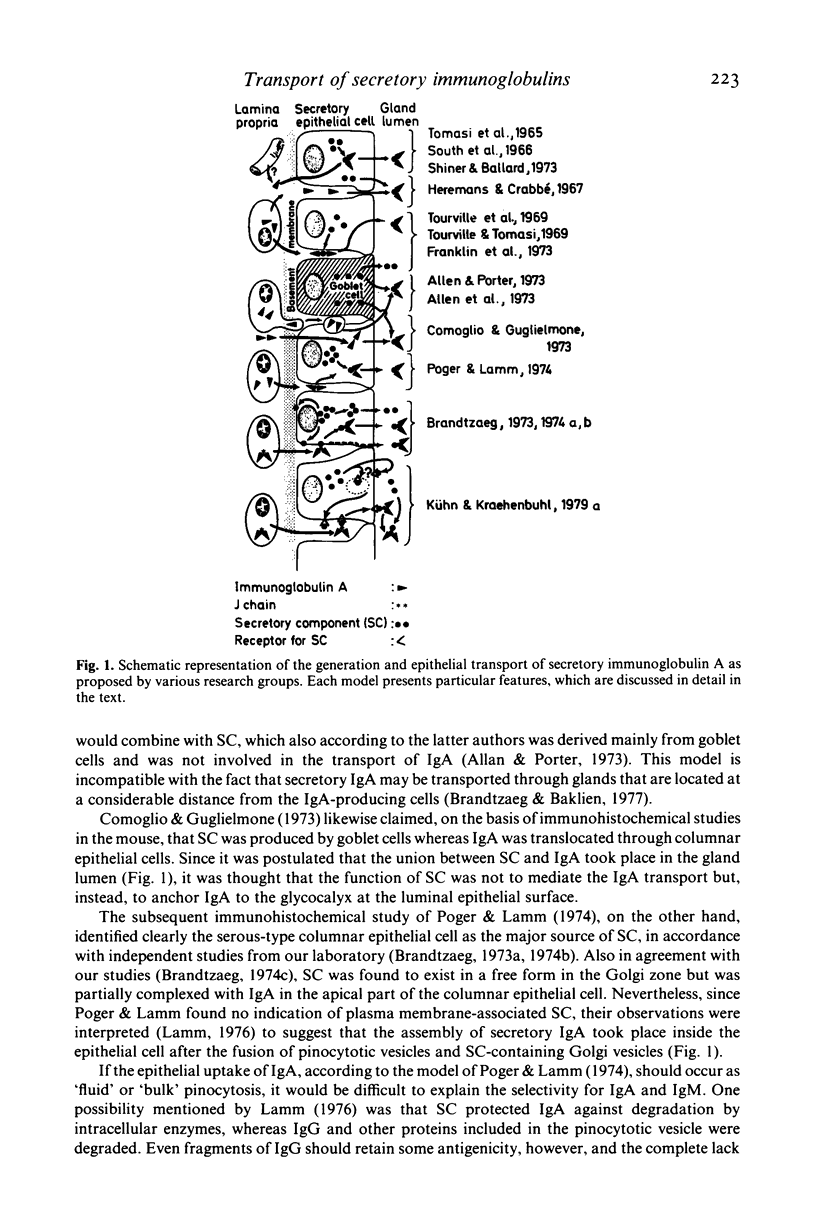
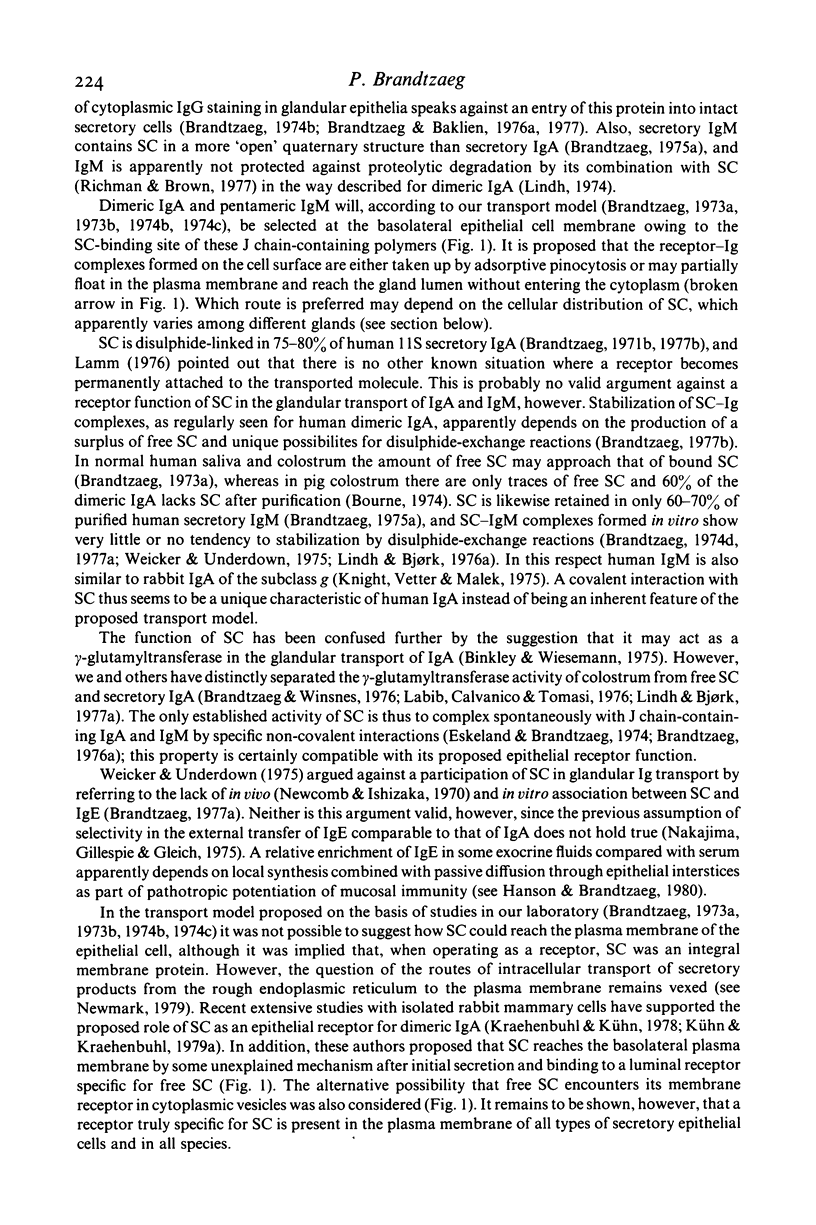
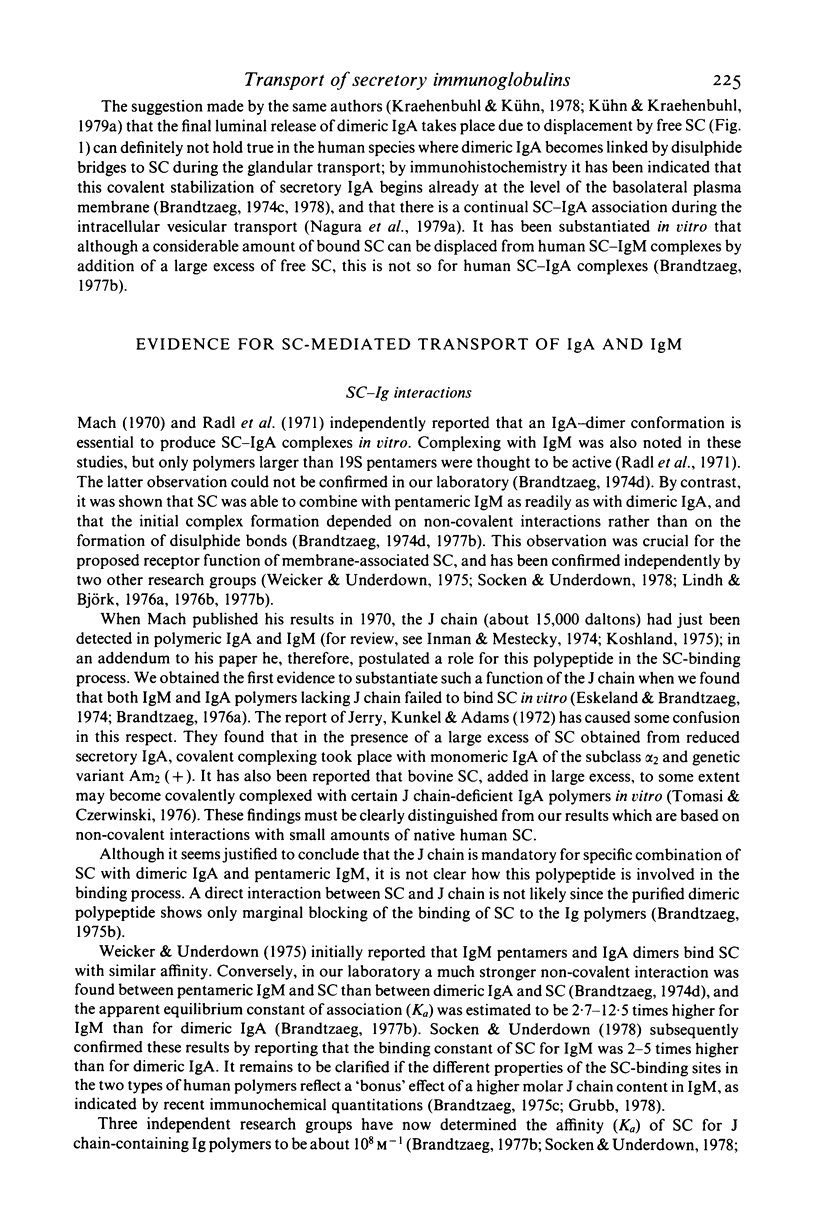
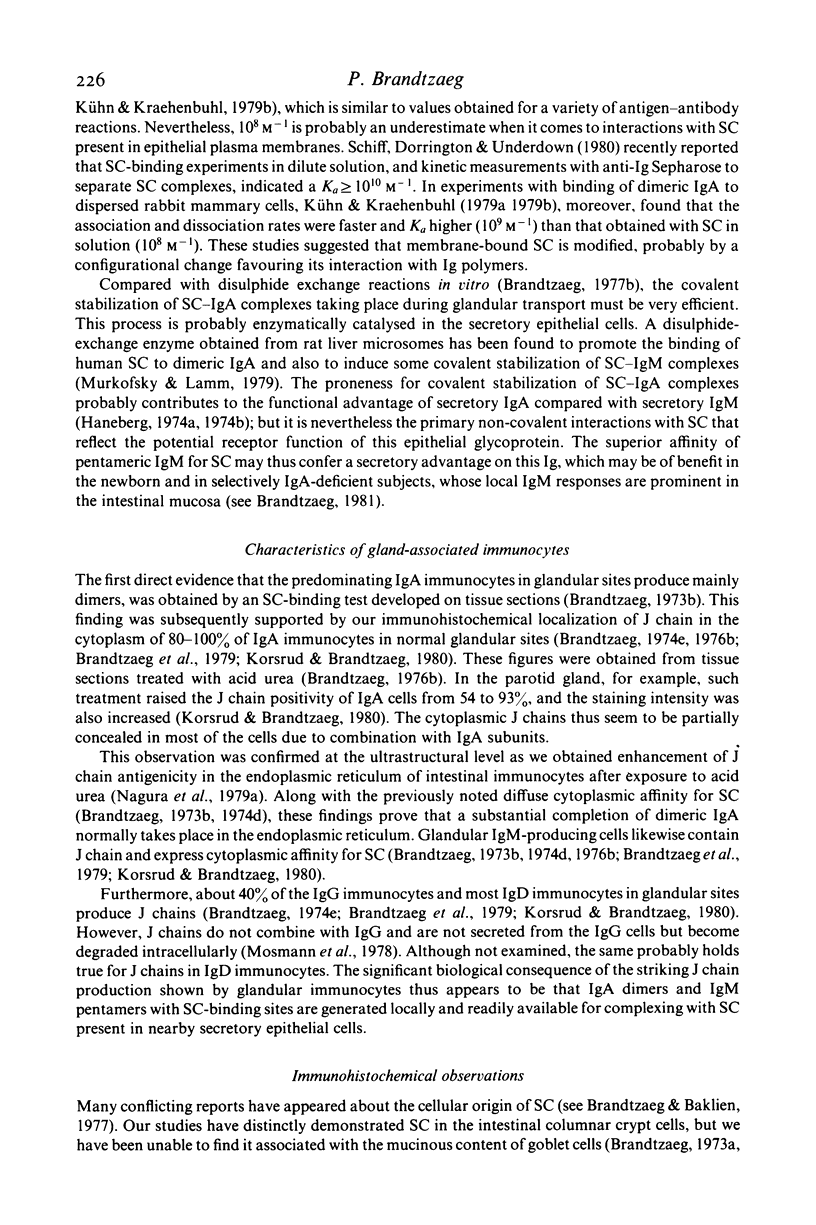
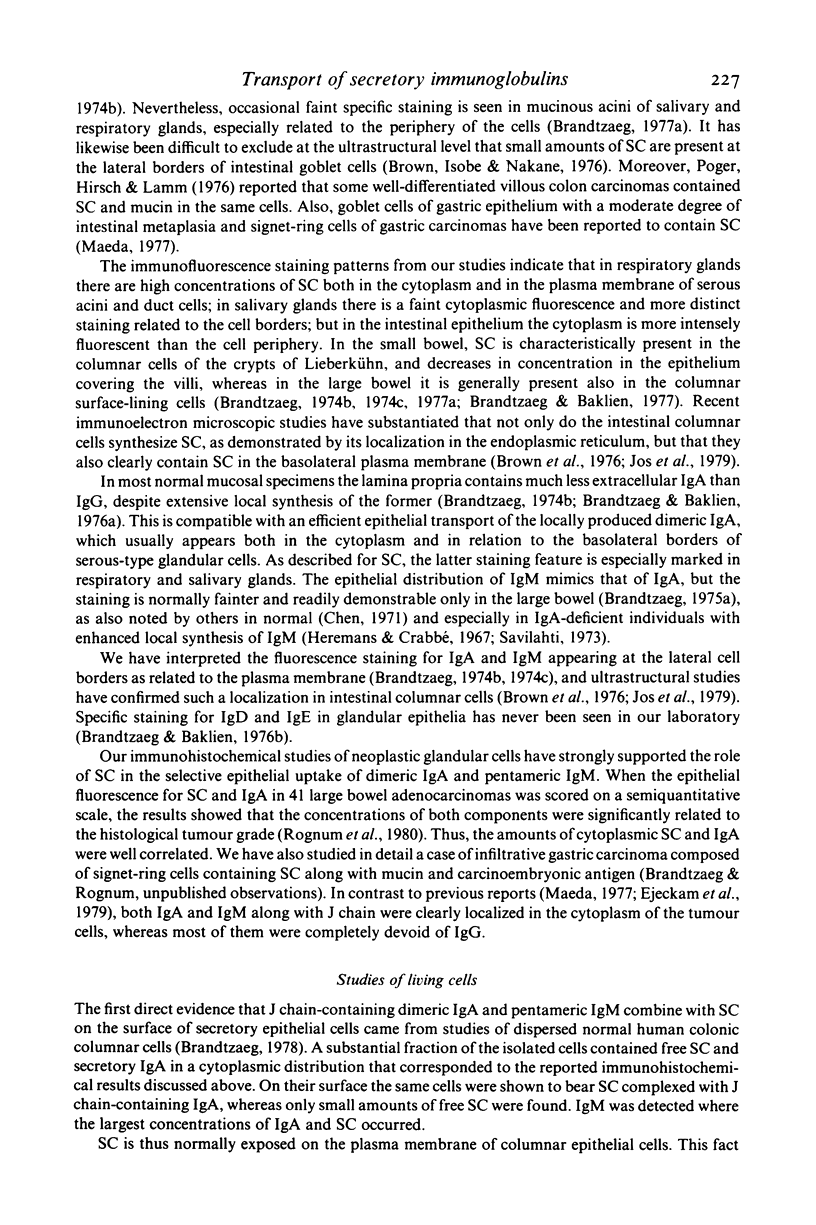
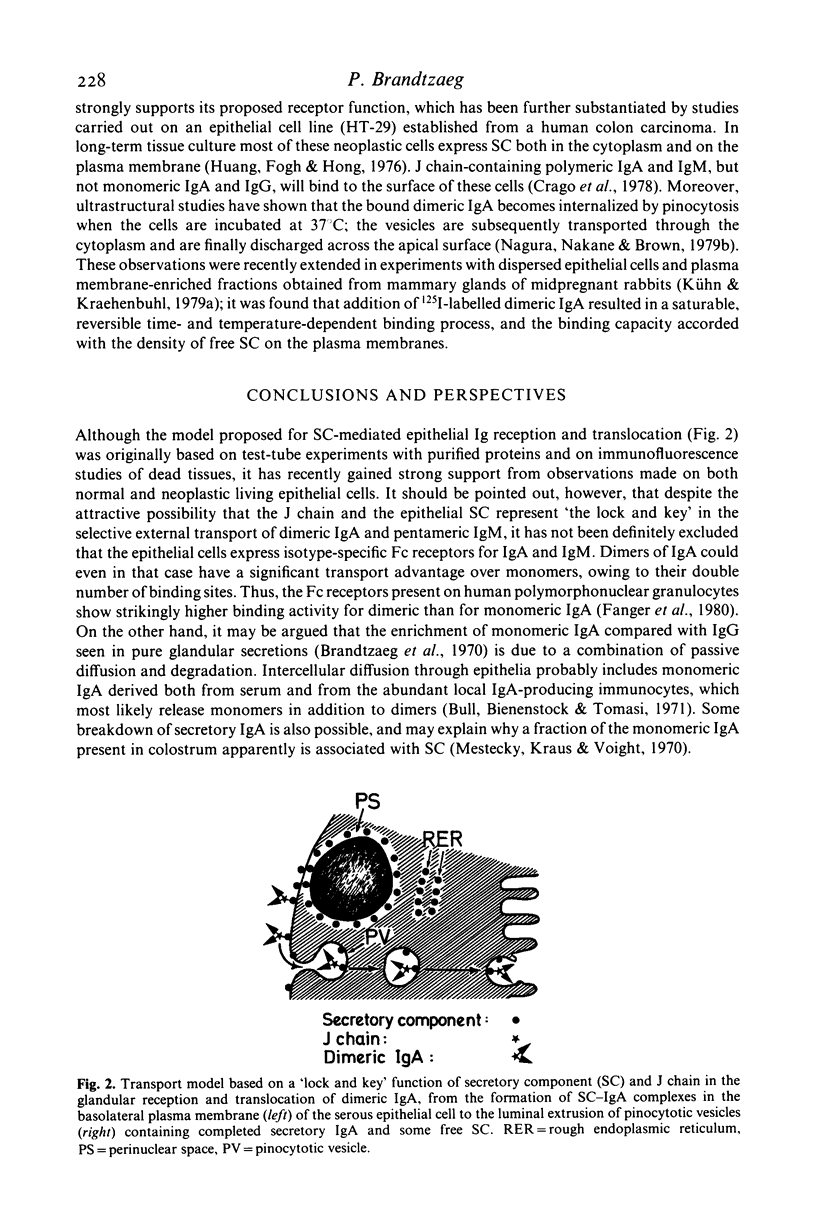
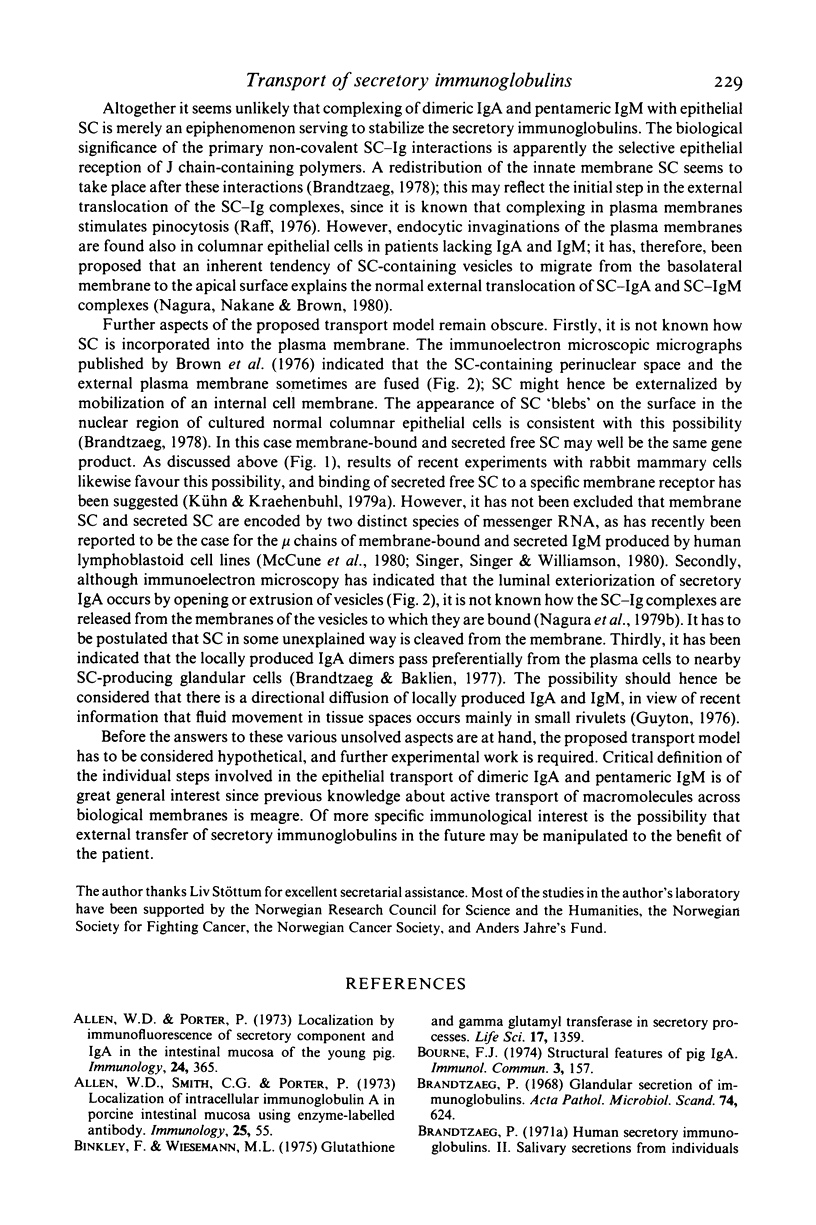
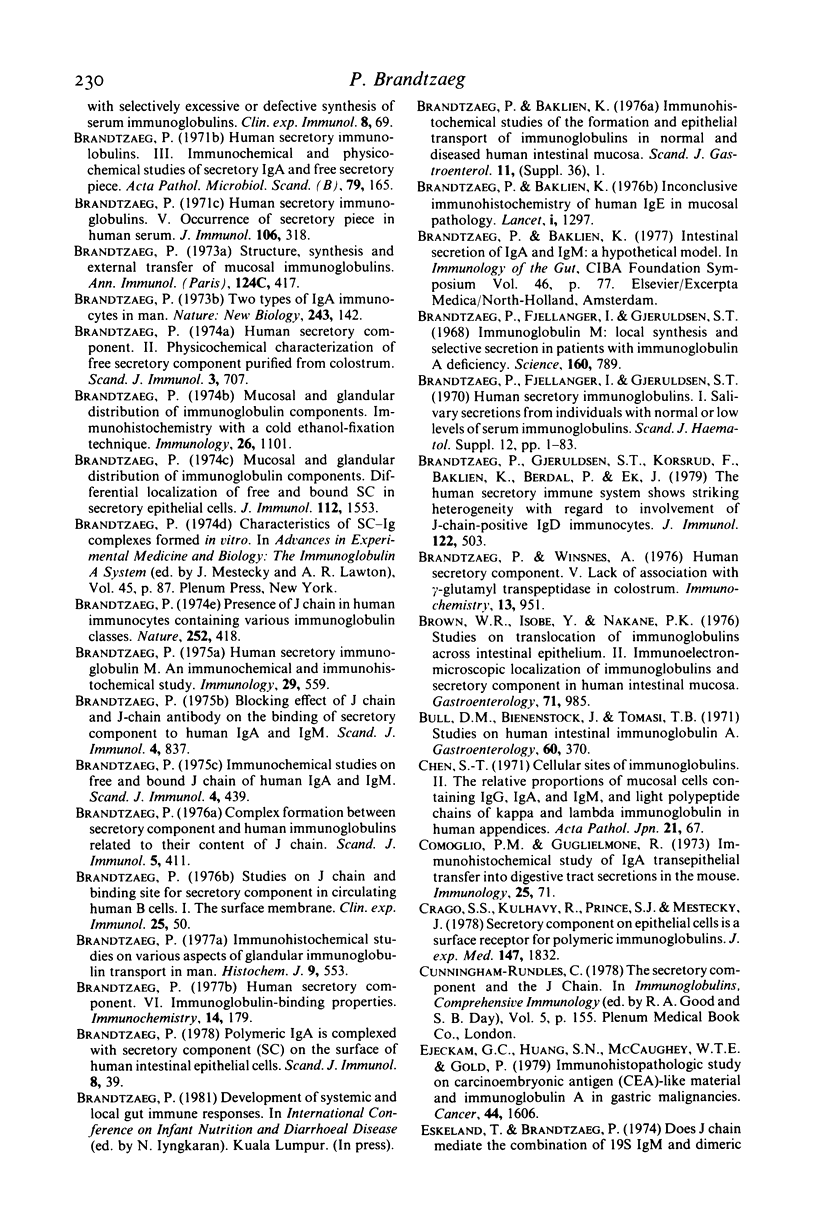
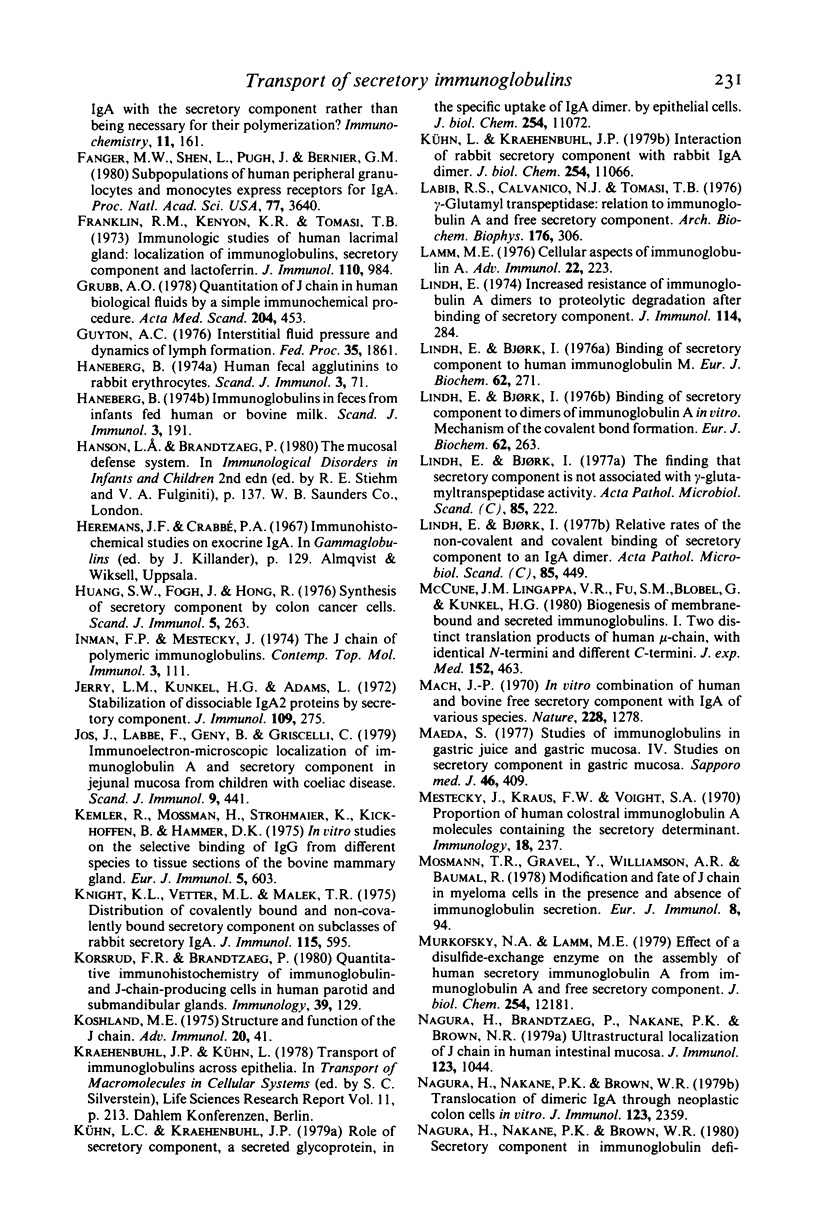
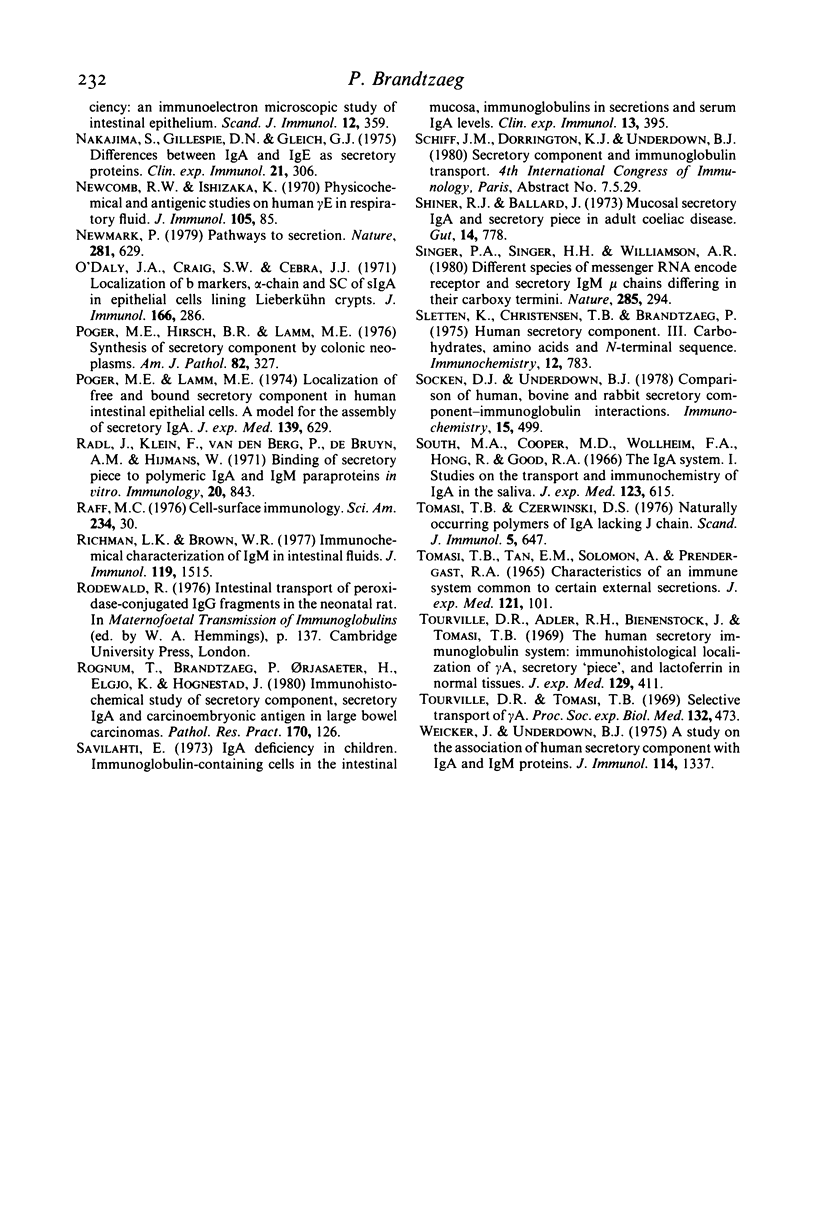
Selected References
These references are in PubMed. This may not be the complete list of references from this article.
- Allen W. D., Porter P. Localization by immunofluorescence of secretory component and IgA in the intestinal mucosa of the young pig. Immunology. 1973 Feb;24(2):365–374. [PMC free article] [PubMed] [Google Scholar]
- Allen W. D., Smith C. G., Porter P. Localization of intracellular immunoglobulin A in porcine intestinal mucosa using enzyme-labelled antibody. An ultrastructural study. Immunology. 1973 Jul;25(1):55–70. [PMC free article] [PubMed] [Google Scholar]
- Binkley F., Wiesemann M. L. Glutathione and gamma glutamyl transferase in secretory processes. Life Sci. 1975 Nov 1;17(9):1359–1361. doi: 10.1016/0024-3205(75)90152-6. [DOI] [PubMed] [Google Scholar]
- Brandtzaeg P., Baklien K. Inconclusive immunohistochemistry of human IgE in mucosal pathology. Lancet. 1976 Jun 12;1(7972):1297–1298. doi: 10.1016/s0140-6736(76)91767-0. [DOI] [PubMed] [Google Scholar]
- Brandtzaeg P. Blocking effect of J chain and J-chain antibody on the binding of secretory component to human IgA and IgM. Scand J Immunol. 1975;4(8):837–842. doi: 10.1111/j.1365-3083.1975.tb03725.x. [DOI] [PubMed] [Google Scholar]
- Brandtzaeg P., Fjellanger I., Gjeruldsen S. T. Human secretory immunoglobulins. I. Salivary secretions from individuals with normal or low levels of serum immunoglobulins. Scand J Haematol Suppl. 1970;12:3–83. [PubMed] [Google Scholar]
- Brandtzaeg P., Fjellanger I., Gjeruldsen S. T. Immunoglobulin M: local synthesis and selective secretion in patients with immunoglobulin A deficiency. Science. 1968 May 17;160(3829):789–791. doi: 10.1126/science.160.3829.789. [DOI] [PubMed] [Google Scholar]
- Brandtzaeg P., Gjeruldsen S. T., Korsrud F., Baklien K., Berdal P., Ek J. The human secretory immune system shows striking heterogeneity with regard to involvement of J chain-positive IgD immunocytes. J Immunol. 1979 Feb;122(2):503–510. [PubMed] [Google Scholar]
- Brandtzaeg P. Human secretory component--VI. Immunoglobulin-binding properities. Immunochemistry. 1977 Mar;14(3):179–188. doi: 10.1016/0019-2791(77)90192-6. [DOI] [PubMed] [Google Scholar]
- Brandtzaeg P. Human secretory component. II. Physicochemical characterization of free secretory component purified from colostrum. Scand J Immunol. 1974;3(6):707–716. doi: 10.1111/j.1365-3083.1974.tb01306.x. [DOI] [PubMed] [Google Scholar]
- Brandtzaeg P. Human secretory immunoglobulin M. An immunochemical and immunohistochemical study. Immunology. 1975 Sep;29(3):559–570. [PMC free article] [PubMed] [Google Scholar]
- Brandtzaeg P. Human secretory immunoglobulins. 3. Immunochemical and physicochemical studies of secretory IgA and free secretory piece. Acta Pathol Microbiol Scand B Microbiol Immunol. 1971;79(2):165–188. [PubMed] [Google Scholar]
- Brandtzaeg P. Human secretory immunoglobulins. II. Salivary secretions from individuals with selectively excessive or defective synthesis of serum immunoglobulins. Clin Exp Immunol. 1971 Jan;8(1):69–85. [PMC free article] [PubMed] [Google Scholar]
- Brandtzaeg P. Human secretory immunoglobulins. V. Occurrence of secretory piece in human serum. J Immunol. 1971 Feb;106(2):318–323. [PubMed] [Google Scholar]
- Brandtzaeg P. Immunochemical studies on free and bound J chain of human IgA and IgM. Scand J Immunol. 1975 Sep;4(5-6):439–450. doi: 10.1111/j.1365-3083.1975.tb02649.x. [DOI] [PubMed] [Google Scholar]
- Brandtzaeg P. Immunohistochemical studies on various aspects of glandular immunoglobulin transport in man. Histochem J. 1977 Sep;9(5):553–572. doi: 10.1007/BF01002902. [DOI] [PubMed] [Google Scholar]
- Brandtzaeg P. Mucosal and glandular distribution of immunoglobulin components. Immunohistochemistry with a cold ethanol-fixation technique. Immunology. 1974 Jun;26(6):1101–1114. [PMC free article] [PubMed] [Google Scholar]
- Brandtzaeg P. Mucosal and glandular distribution of immunoglobulin components: differential localization of free and bound SC in secretory epithelial cells. J Immunol. 1974 Apr;112(4):1553–1559. [PubMed] [Google Scholar]
- Brandtzaeg P. Polymeric IgA is complexed with secretory component (SC) on the surface of human intestinal epithelial cells. Scand J Immunol. 1978;8(1):39–52. doi: 10.1111/j.1365-3083.1978.tb00494.x. [DOI] [PubMed] [Google Scholar]
- Brandtzaeg P. Structure, synthesis and external transfer of mucosal immunoglobulins. Ann Immunol (Paris) 1973 Aug;124(3):417–438. [PubMed] [Google Scholar]
- Brandtzaeg P. Studies on J chain and binding site for secretory component in circulating human B cells. Clin Exp Immunol. 1976 Jul;25(1):50–58. [PMC free article] [PubMed] [Google Scholar]
- Brandtzaeg P. Two types of IgA immunocytes in man. Nat New Biol. 1973 May 30;243(126):142–143. doi: 10.1038/newbio243142a0. [DOI] [PubMed] [Google Scholar]
- Brandtzaeg P., Winsnes A. Human secretory component--V. Lack of association with gamma-glutamyl transpeptidase in colostrum. Immunochemistry. 1976 Dec;13(12):951–954. [PubMed] [Google Scholar]
- Brown W. R., Isobe Y., Nakane P. K. Studies on translocation of immunoglobulins across intestinal epithelium. II. Immunoelectron-microscopic localization of immunoglobulins and secretory component in human intestinal mucosa. Gastroenterology. 1976 Dec;71(6):985–995. [PubMed] [Google Scholar]
- Bull D. M., Bienenstock J., Tomasi T. B., Jr Studies on human intestinal immunoglobulin A. Gastroenterology. 1971 Mar;60(3):370–380. [PubMed] [Google Scholar]
- Chen S. T. Cellular sites of immunoglobulins. II. The relative proportions of mucosal cells containing IgG, IgA, and IgM, and light polypeptide chains of kappa and lambda immunoglobulin in human appendices. Acta Pathol Jpn. 1971 Feb;21(1):67–83. [PubMed] [Google Scholar]
- Comoglio P. M., Guglielmone R. Immunohistochemical study of IgA transepithelial transfer into digestive tract secretions in the mouse. Immunology. 1973 Jul;25(1):71–80. [PMC free article] [PubMed] [Google Scholar]
- Crago S. S., Kulhavy R., Prince S. J., Mestecky J. Secretory component of epithelial cells is a surface receptor for polymeric immunoglobulins. J Exp Med. 1978 Jun 1;147(6):1832–1837. doi: 10.1084/jem.147.6.1832. [DOI] [PMC free article] [PubMed] [Google Scholar]
- Ejeckam G. C., Huang S. N., McCaughey W. T., Gold P. Immunohistopathologic study on carcinoembryonic antigen (CEA)-like material and immunoglobulin A in gastric malignancies. Cancer. 1979 Nov;44(5):1606–1614. doi: 10.1002/1097-0142(197911)44:5<1606::aid-cncr2820440511>3.0.co;2-r. [DOI] [PubMed] [Google Scholar]
- Eskeland T., Brandtzaeg P. Does J chain mediate the combination of 19S IgM and dimeric IgA with the secretory component rather than being necessary for their polymerization? Immunochemistry. 1974 Mar;11(3):161–163. doi: 10.1016/0019-2791(74)90214-6. [DOI] [PubMed] [Google Scholar]
- Fanger M. W., Shen L., Pugh J., Bernier G. M. Subpopulations of human peripheral granulocyes and monocytes express receptors for IgA. Proc Natl Acad Sci U S A. 1980 Jun;77(6):3640–3644. doi: 10.1073/pnas.77.6.3640. [DOI] [PMC free article] [PubMed] [Google Scholar]
- Grubb A. O. Quantitation of J chain in human biological fluids by a simple immunochemical procedure. Acta Med Scand. 1978;204(6):453–465. doi: 10.1111/j.0954-6820.1978.tb08473.x. [DOI] [PubMed] [Google Scholar]
- Guyton A. C. Interstitial fluid pressure and dynamics of lymph formation. Introduction. Fed Proc. 1976 Jun;35(8):1861–1862. [PubMed] [Google Scholar]
- Haneberg B. Human fetal agglutinins to rabbit erythrocytes. Scand J Immunol. 1974;3(1):71–76. doi: 10.1111/j.1365-3083.1974.tb01234.x. [DOI] [PubMed] [Google Scholar]
- Haneberg B. Immunoglobulins in feces from infants fed human or bovine milk. Scand J Immunol. 1974;3(2):191–197. doi: 10.1111/j.1365-3083.1974.tb01247.x. [DOI] [PubMed] [Google Scholar]
- Huang S. W., Fogh J., Hong R. Synthesis of secretory component by human colon cancer cells. Scand J Immunol. 1976;5(3):263–268. doi: 10.1111/j.1365-3083.1976.tb00277.x. [DOI] [PubMed] [Google Scholar]
- Inman F. P., Mestecky J. The J chain of polymeric immunoglobulins. Contemp Top Mol Immunol. 1974;3:111–141. doi: 10.1007/978-1-4684-2838-4_5. [DOI] [PubMed] [Google Scholar]
- Jerry L. M., Kunkel H. G., Adams L. Stabilization of dissociable IgA2 proteins by secretory component. J Immunol. 1972 Aug;109(2):275–283. [PubMed] [Google Scholar]
- Jos J., Labbe F., Geny B., Griscelli C. Immunoelectron-microscopic localization of immunoglobulin A and secretory component in jejunal mucosa from children with coeliac disease. Scand J Immunol. 1979;9(5):441–450. doi: 10.1111/j.1365-3083.1979.tb03066.x. [DOI] [PubMed] [Google Scholar]
- Kemler R., Mossmann H., Strohmaier U., Kickhöfen B., Hammer D. K. In vitro studies on the selective binding of IgG from different species to tissue sections of the bovine mammary gland. Eur J Immunol. 1975 Sep;5(9):603–608. doi: 10.1002/eji.1830050905. [DOI] [PubMed] [Google Scholar]
- Knight K. L., Vetter M. L., Malek T. R. Distribution of covalently bound and non-covalently bound secretory component on sbuclasses of rabbit secretory IgA. J Immunol. 1975 Aug;115(2):595–598. [PubMed] [Google Scholar]
- Korsrud F. R., Brandtzaeg P. Quantitative immunohistochemistry of immunoglobulin- and J-chain-producing cells in human parotid and submandibular salivary glands. Immunology. 1980 Feb;39(2):129–140. [PMC free article] [PubMed] [Google Scholar]
- Koshland M. E. Structure and function of the J chain. Adv Immunol. 1975;20:41–69. doi: 10.1016/s0065-2776(08)60206-0. [DOI] [PubMed] [Google Scholar]
- Kühn L. C., Kraehenbuhl J. P. Interaction of rabbit secretory component with rabbit IgA dimer. J Biol Chem. 1979 Nov 10;254(21):11066–11071. [PubMed] [Google Scholar]
- Kühn L. C., Kraehenbuhl J. P. Role of secretory component, a secreted glycoprotein, in the specific uptake of IgA dimer by epithelial cells. J Biol Chem. 1979 Nov 10;254(21):11072–11081. [PubMed] [Google Scholar]
- Labib R. S., Calvanico N. J., Tomasi T. B. gamma-Glutamyl transpeptidase: relation to immunoglobulin A and free secretory component. Arch Biochem Biophys. 1976 Sep;176(1):306–313. doi: 10.1016/0003-9861(76)90169-7. [DOI] [PubMed] [Google Scholar]
- Lamm M. E. Cellular aspects of immunoglobulin A. Adv Immunol. 1976;22:223–290. doi: 10.1016/s0065-2776(08)60550-7. [DOI] [PubMed] [Google Scholar]
- Lindh E., Björk I. Binding of secretory component to dimers of immunoglobulin A in vitro. Mechanism of the covalent bond formation. Eur J Biochem. 1976 Feb 16;62(2):263–270. doi: 10.1111/j.1432-1033.1976.tb10156.x. [DOI] [PubMed] [Google Scholar]
- Lindh E., Björk I. Binding of secretory component to human immunoglobulin M. Eur J Biochem. 1976 Feb 16;62(2):271–278. doi: 10.1111/j.1432-1033.1976.tb10157.x. [DOI] [PubMed] [Google Scholar]
- Lindh E., Björk I. Relative rates of the non-covalent and covalent binding of secretory component to an IgA dimer. Acta Pathol Microbiol Scand C. 1977 Dec;85C(6):449–453. doi: 10.1111/j.1699-0463.1977.tb03667.x. [DOI] [PubMed] [Google Scholar]
- Lindh E., Björk I. The finding that secretory component is not associated with gamma-glutamyltranspeptidase activity. Acta Pathol Microbiol Scand C. 1977 Jun;85(3):222–224. doi: 10.1111/j.1699-0463.1977.tb03634.x. [DOI] [PubMed] [Google Scholar]
- Lindh E. Increased risistance of immunoglobulin A dimers to proteolytic degradation after binding of secretory component. J Immunol. 1975 Jan;114(1 Pt 2):284–286. [PubMed] [Google Scholar]
- Mach J. P. In vitro combination of human and bovine free secretory component with IgA of various species. Nature. 1970 Dec 26;228(5278):1278–1282. doi: 10.1038/2281278a0. [DOI] [PubMed] [Google Scholar]
- McCune J. M., Lingappa V. R., Fu S. M., Blobel G., Kunkel H. G. Biogenesis of membrane-bound and secreted immunoglobulins. I. Two distinct translation products of human mu-chain, with identical N-termini and different C-termini. J Exp Med. 1980 Aug 1;152(2):463–468. doi: 10.1084/jem.152.2.463. [DOI] [PMC free article] [PubMed] [Google Scholar]
- Mestecky J., Kraus F. W., Voight S. A. Proportion of human colostral immunoglobulin-A molecules containing the secretory determinant. Immunology. 1970 Feb;18(2):237–243. [PMC free article] [PubMed] [Google Scholar]
- Mosmann T. R., Gravel Y., Williamson A. R., Baumal R. Modification and fate of J chain in myeloma cells in the presence and absence of polymeric immunoglobulin secretion. Eur J Immunol. 1978 Feb;8(2):94–101. doi: 10.1002/eji.1830080205. [DOI] [PubMed] [Google Scholar]
- Murkofsky N. A., Lamm M. E. Effect of a disulfide-interchange enzyme on the assembly of human secretory immunoglobulin A from immunoglobulin A and free secretory component. J Biol Chem. 1979 Dec 10;254(23):12181–12184. [PubMed] [Google Scholar]
- Nagura H., Brandtzaeg P., Nakane P. K., Brown W. R. Ultrastructural localization of J chain in human intestinal mucosa. J Immunol. 1979 Sep;123(3):1044–1050. [PubMed] [Google Scholar]
- Nagura H., Nakane P. K., Brown W. R. Secretory component in immmunoglobulin deficiency: and immunoelectron microscopic study of intestinal epithelium. Scand J Immunol. 1980;12(4):359–363. doi: 10.1111/j.1365-3083.1980.tb00078.x. [DOI] [PubMed] [Google Scholar]
- Nagura H., Nakane P. K., Brown W. R. Translocation of dimeric IgA through neoplastic colon cells in vitro. J Immunol. 1979 Nov;123(5):2359–2368. [PubMed] [Google Scholar]
- Nakajima S., Gillespie D. N., Gleich G. J. Differences between IgA and IgE as secretory proteins. Clin Exp Immunol. 1975 Aug;21(2):306–317. [PMC free article] [PubMed] [Google Scholar]
- Newcomb R. W., Ishizaka K. Physicochemical and antigenic studies on human gamma E in respiratory fluid. J Immunol. 1970 Jul;105(1):85–89. [PubMed] [Google Scholar]
- Newmark P. Pathways to secretion. Nature. 1979 Oct 25;281(5733):629–630. doi: 10.1038/281629a0. [DOI] [PubMed] [Google Scholar]
- O'Daly J. A., Craig S. W., Cebra J. J. Localization of b markers, alpha-chain and SC of SIgA in epithelial cells lining Lieberkühn crypts. J Immunol. 1971 Jan;106(1):286–288. [PubMed] [Google Scholar]
- Poger M. E., Hirsch B. R., Lamm M. E. Synthesis of secretory component by colonic neoplasms. Am J Pathol. 1976 Feb;82(2):327–338. [PMC free article] [PubMed] [Google Scholar]
- Poger M. E., Lamm M. E. Localization of free and bound secretory component in human intestinal epithelial cells. A model for the assembly of secretory IgA. J Exp Med. 1974 Mar 1;139(3):629–642. doi: 10.1084/jem.139.3.629. [DOI] [PMC free article] [PubMed] [Google Scholar]
- Raff M. C. Cell-surface immunology. Sci Am. 1976 May;234(5):30–39. doi: 10.1038/scientificamerican0576-30. [DOI] [PubMed] [Google Scholar]
- Richman L. K., Brown W. R. Immunochemical characterization of IgM in human intestinal fluids. J Immunol. 1977 Oct;119(4):1515–1519. [PubMed] [Google Scholar]
- Rognum T. O., Brandtzaeg P., Orjasaeter H., Elgjo K., Hognestad J. Immunohistochemical study of secretory component, secretory IgA and carcinoembryonic antigen in large bowel carcinomas. Pathol Res Pract. 1980 Dec;170(1-3):126–145. doi: 10.1016/s0344-0338(80)80161-0. [DOI] [PubMed] [Google Scholar]
- Rádl J., Klein F., van den Berg P., de Bruyn A. M., Hijmans W. Binding of secretory piece to polymeric IgA and IgM paraproteins in vitro. Immunology. 1971 May;20(5):843–852. [PMC free article] [PubMed] [Google Scholar]
- Savilahti E. IgA deficiency in children. Immunoglobulin-containing cells in the intestinal mucosa, immunoglobulins in secretions and serum IgA levels. Clin Exp Immunol. 1973 Mar;13(3):395–406. [PMC free article] [PubMed] [Google Scholar]
- Shiner R. J., Ballard J. Mucosal secretory IgA and secretory piece in adult coeliac disease. Gut. 1973 Oct;14(10):778–783. doi: 10.1136/gut.14.10.778. [DOI] [PMC free article] [PubMed] [Google Scholar]
- Singer P. A., Singer H. H., Williamson A. R. Different species of messenger RNA encode receptor and secretory IgM mu chains differing at their carboxy termini. Nature. 1980 May 29;285(5763):294–300. doi: 10.1038/285294a0. [DOI] [PubMed] [Google Scholar]
- Sletten K., Christensen T. B., Brandtzaeg P. Human secretory component--III. Carbohydrates, amino acids and N-terminal sequence. Immunochemistry. 1975 Sep;12(9):783–785. [PubMed] [Google Scholar]
- Socken D. J., Underdown B. J. Comparison of human, bovine and rabbit secretory component-immunoglobulin interactions. Immunochemistry. 1978 Jul;15(7):499–506. doi: 10.1016/0161-5890(78)90080-9. [DOI] [PubMed] [Google Scholar]
- South M. A., Cooper M. D., Wollheim F. A., Hong R., Good R. A. The IgA system. I. Studies of the transport and immunochemistry of IgA in the saliva. J Exp Med. 1966 Apr 1;123(4):615–627. doi: 10.1084/jem.123.4.615. [DOI] [PMC free article] [PubMed] [Google Scholar]
- TOMASI T. B., Jr, TAN E. M., SOLOMON A., PRENDERGAST R. A. CHARACTERISTICS OF AN IMMUNE SYSTEM COMMON TO CERTAIN EXTERNAL SECRETIONS. J Exp Med. 1965 Jan 1;121:101–124. doi: 10.1084/jem.121.1.101. [DOI] [PMC free article] [PubMed] [Google Scholar]
- Tomasi T. B., Czerwinski D. S. Naturally occurring polymers of IgA lacking J chain. Scand J Immunol. 1976;5(6-7):647–653. doi: 10.1111/j.1365-3083.1976.tb03014.x. [DOI] [PubMed] [Google Scholar]
- Tourville D. R., Adler R. H., Bienenstock J., Tomasi T. B., Jr The human secretory immunoglobulin system: immunohistoligical localization of gamma A, secretory "piece," and lactoferrin in normal human tissues. J Exp Med. 1969 Feb 1;129(2):411–429. doi: 10.1084/jem.129.2.411. [DOI] [PMC free article] [PubMed] [Google Scholar]
- Tourville D. R., Tomasi T. B., Jr Selective transport of gamma A. Proc Soc Exp Biol Med. 1969 Nov;132(2):473–477. [PubMed] [Google Scholar]
- Weicker J., Underdown B. J. A study of the association of human secretory component with IgA and IgM proteins. J Immunol. 1975 Apr;114(4):1337–1344. [PubMed] [Google Scholar]


